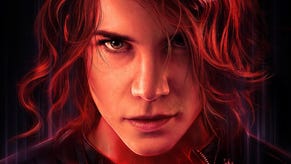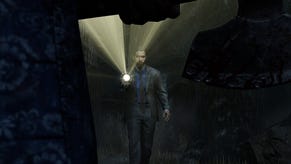Alan Wake 2 on PlayStation 5 - Remedy raises the bar for visuals yet again
Plus: how the console experience stacks up against PC at its best.
Earned across decades of development, Remedy Entertainment has a stellar reputation for pushing game technology to new heights. From the physics-driven mayhem of Max Payne 2 to the ray-traced brutalism of Control, and of course the volumetrics-heavy wilderness of Alan Wake, each major Remedy release has pushed visual boundaries on its host hardware. Alan Wake 2 is no exception: this is a top-flight technical treat that pushes modern systems hard, with often extraordinary visual results.
We've got a lot to say about Alan Wake 2 and we'll be following up with coverage of Xbox Series hardware and, of course, the incredible PC version of the game but for now, we'll be focusing on the PlayStation 5 version of the game, where it's fair to say that Remedy has delivered a properly state-of-the-art experience. Yes, there are clear compromises stacked up against the maxed out PC version of the game, but the point is that the studio has finely tuned a creditable console release. It may not have all the bells and whistles, but the key fundamentals are all there. Alan Wake 2 on consoles is a perfectly fine way to enjoy the game.
Let's be clear. Alan Wake 2 is an extremely impressive technical and artistic achievement, and a brilliant showcase for Remedy's in-house Northlight game engine. A lot of its impact comes down to the game's very high quality indirect lighting. Every environment has an excellent presentation of global illumination, with light bouncing convincingly through constrained hallways and forested outdoor areas alike. The consistency of the lighting is really what stands out here: I had a very hard time spotting any problems, even in the typical problem areas for games we often highlight in our videos. Characters also blend seamlessly with the lighting presentation, and never seem to stick out, glow or look awkward.
It looks like Alan Wake 2 uses a 'baked' or precalculated global illumination solution here alongside screen-space ambient occlusion to deal with indirect lighting, and the combination produces excellent results. If you look closely, you can spot some minor artifacts in the baked lighting in the environment, but in typical play the results hold up very well. That holds true in heavily overcast conditions, filling out low-contrast scenes with subtle depth. It's also the case in naturally-lit interiors, with light from the sun beautifully illuminating constrained spaces, while the game's moody, artificially-lit nighttime scenes also look fantastic. Volumetrics are used heavily throughout the game, like prior Remedy efforts, which gives lighting a thick, heavy look that accentuates Alan Wake 2's dark mood.
Materials are accurately differentiated too, with a wide range of lighting responses. For example, the diffuse fabrics of Alan's coat look perfectly accurate as you walk under the soft lights. The glossy floor and soft leather seats in the diner create a beautiful contrast in that particular scene, with every flavour of wood and pasty skin tone in the nursing home looking perfectly true-to-life. At times, it looks more like a CG movie than a video game, because the materials sit perfectly within each environment and just look natural.
Alan Wake 2 is absolutely packed with geometric detail as well. Assets in the game are universally high-poly, and look good even at extreme close range. Pop-in is kept to a minimum, though environments do tend to be a bit on the smaller side. Remedy loves to throw around all kinds of detritus through the game - empty beer bottles, spare coolers, and other remnants of despair and disuse. Foliage outdoors is top-notch as well, with incredible density and of course a convincing reaction to the player flashlight and to changing environmental conditions. The super-high quality of the rendering makes a lot of Remedy's creative choices land in a way they wouldn't with more conservative technology. The game has some very inventive environments in addition to areas that feel more familiar. Some of the sequences in Alan Wake 2 could come across as awkward with less sophisticated rendering, and a few of the moments of levity would seem funny for all the wrong reasons.
The high quality of the character models helps a lot too. Facial detail is exquisite and skin shading looks accurate and correct across a wide range of lighting conditions. Hair seems to be card-based (effectively 2D layered textures), but looks appropriately complex and animates reasonably well. A few cutscene moments do seem a bit uncanny though, and facial animation doesn't always match the fidelity of the facial rendering. Perhaps the use of separate character face models and voice actors throws up some production hurdles, though mostly the results look perfectly fine I'd say.
Of course, that isn't as much of an issue for the game's live-action cutscenes, of which there are quite a few. These seem to emphasize Alan Wake's more surreal elements, and are often used in some of the bizarre interludes that convey much of the game's plot. Video quality is fine, though the heavy film grain does create some macroblocking and the encodes seem to be 1080p. 30fps is the frame-rate here, which presents without frame-pacing issues. High quality videos to match the higher quality rendering would have been preferable.
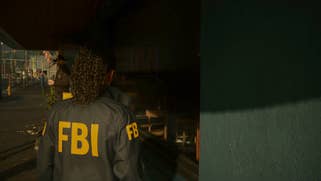



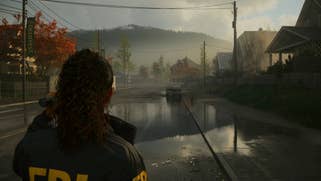
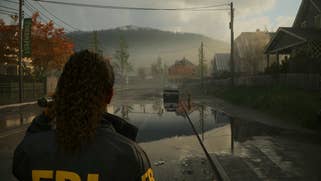


Alan Wake 2's visuals excel, but there are some limitations. Shadows mostly look good on consoles, but they do stick out at times. Sun shadows have a beautifully filtered appearance with nice bokeh shapes, which looks very pleasing, but do have a perceptibly low resolution. Shadow cascades also tend to be quite aggressive, with the highest-resolution shadowmap only coming into view a metre or two from the player. Flashlight shadows are mostly fine, but similarly suffer from low resolution at a distance. These are sensible compromises, and the filtering keeps the shadows coherent enough most of the time, but these concessions are worth noting.
Reflections are a mixed bag on consoles. Alan Wake 2 primarily relies on screen-space reflections, so the game lacks the hardware RT reflections that we saw in Control on consoles, as well as the Remedy-developed single-player component of CrossfireX. These present the usual issues with SSR, namely problems with occlusion, especially for surfaces parallel to the player camera. Plus, sometimes the SSR takes on a bit of a grainy appearance. SDF reflections seem to be used as a fallback, again like recent Remedy titles, which are a kind of software ray tracing, just like Unreal Engine 5's software Lumen reflections. These don't do a great job of maintaining reflection detail though when the information needed for SSR isn't on-screen.
This brings us to the PC release and its path-traced glory. When I started tackling the PS5 code, more than anything else I wanted to know just how much console players were missing out by playing Alan Wake 2 without the game's key ray tracing features. The answer is quite a bit - but less than I expected. Reflections and shadows are obviously cleaned up enormously with path-traced lighting turned on, with pin-sharp mirror reflections across calm bodies of water and mirrors. Disocclusion issues on PS5 prove no problem at all for PC: transparent surfaces are also path-traced, which can look phenomenal.
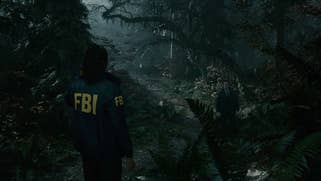
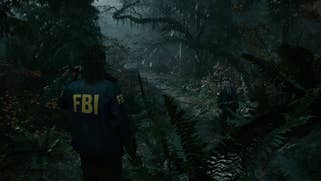

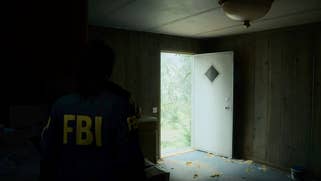
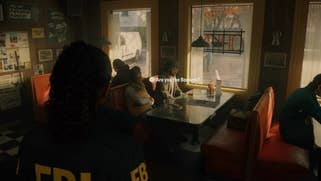
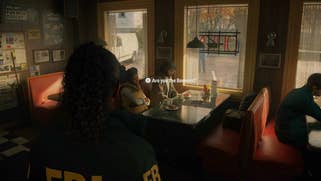


Shadows now exhibit realistic fall-off and variable penumbra as they grow more distant from the casting object. Shadows up close are pin-sharp, while shadows further from the source become light and faint. Aliased shadowmaps are a thing of the past here, with a super consistent and realistic RT shadow presentation throughout. Foliage animation is retained in the ray tracing, which is something we don't always see in games with RT shadows. You can consider the maxed-out PC version of Alan Wake 2 as being the definitive article, but the point is that the console versions are making intelligent trades based on their capabilities - and it works.
For example, the actual quality of the indirect lighting on PS5 isn't a world apart on PC with path tracing. We will have more on the game's path-tracing in subsequent videos, but my personal impression is that console players aren't missing out on an enormous amount by sticking with their consoles. I was worried that we'd be seeing a repeat of the Cyberpunk 2077 situation, where PC players get an incredible path-traced experience that the consoles come nowhere near replicating, but that's not the case here. In Alan Wake 2, the PS5 presentation looks awesome, it's just that the path-traced experience cleans up the flaws that do exist in the PS5's lighting. Image quality is also superior of course, as you might expect with the DLSS-driven image on PC. The path-traced PC version does look a lot better, but it doesn't embarrass the consoles, which is an important distinction.
Next up, let's talk quality modes. Alan Wake 2 was designed for 30fps on consoles - and that's what you get in the quality mode. However, towards the end of development, Remedy added a performance option targeting 60fps. The key differentiator here is resolution, as you might expect. The quality mode uses FSR 2 to hit a 2160p output, with an internal resolution of 1270p. Performance mode again uses FSR 2, but this time with an output of 1440p and an internal resolution of 847p. Both modes look a touch softer than most other games with similar output resolutions though, perhaps owing to the lower-contrast artwork and heavy post-processing. Beyond resolution, the most obvious cutback in the performance mode is foliage density, which is considerably lower than the quality mode.


Unfortunately image quality can be a bit suspect in Alan Wake 2 on PS5. There's quite a bit of image breakup on fine details, which is noticeable in both visual modes. It's mostly acceptable enough, and I think the overall rendering quality more than justifies the sometimes-spotty upsampling, but it can annoy. I found the aliasing a bit more distracting in the game's artificial areas than in the naturalistic outdoor settings.
In the quality mode, Alan Wake 2 targets 30fps, and generally hits that target. Most gameplay runs perfectly well, with no frame-pacing issues whatsoever, but there are certain specific areas - like the second Saga Anderson mission - that run poorly, with constant sub-30fps performance. Again, there's no big issue in most of the areas you come across, but some environments seem to cause frame-rates to buckle. The performance mode targets 60fps, and actually does a pretty decent job hitting that figure. Most gameplay, especially indoors, runs just fine at 60fps. Again, there are limits though: outdoor areas - particularly the spots that caused us some trouble in the quality mode - often run below 60fps. It's a pretty decent turnout considering the visual quality on display here, but I would like a more consistent 60fps if at all possible via future updates.
I also noticed some glitches while playing that you can check out in the video - the kind of bugginess and jank often seen on games reaching the end of their development. I expect that these issues will be sorted out in time and it's possible that some may have been addressed in the day one patch, where Remedy tells us they're aiming to cross the Ts and dot the Is in terms of polish.
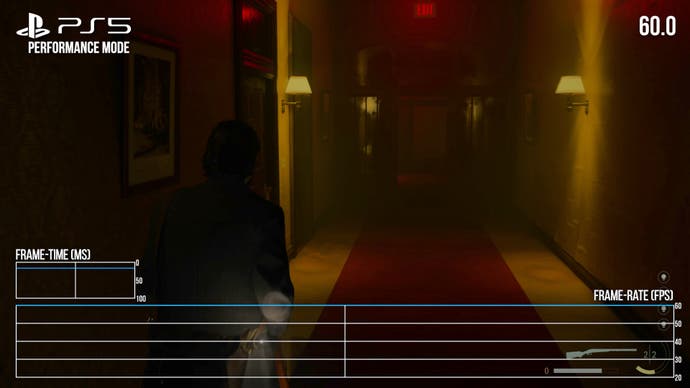

Beyond the technical accomplishment, Alan Wake 2 is a very good game, though it's very different from 2010's Alan Wake original, or its DLC expansions and American Nightmare pseudo-sequel. This is firmly in survival horror territory, with limited combat and a high level of difficulty. The flashlight mechanics are largely preserved from the first game but puzzles and exploration play a much larger role, and the game ultimately doesn't feel much like the earlier titles. And there's a real emphasis on the horror - I found myself quite disturbed at times, with some viscerally intense sequences, difficult subject matter, and agitation-inducing use of split-second flash cuts.
Alan Wake 2's Mind Place and Writer's Room mechanics are genuinely quite cool though, as separate mental worlds where you can sort through case details and rewrite scenes-on-the-fly, unlocking new areas. It's almost like Remedy mashed up Resident Evil with Ace Attorney here, and it works surprisingly well. The game's plot is also a bit of a page turner, though I suspect both new and returning players will need a refresher on the prior titles' stories before starting. I particularly enjoyed the references to Max Payne, Control, and Quantum Break sprinkled throughout.
From a visual perspective though, Alan Wake 2 is an extraordinary effort. On current-gen consoles, there's not much that can rival the incredible density of detail and fine-grained lighting on display here. That's not to say there aren't issues, and performance does need some additional work, but it's hard to say that Alan Wake 2 is anything other than a superb-looking release. For players who like survival horror, and want to experience some of the best technology deployed so far this generation, it's an easy recommendation.





